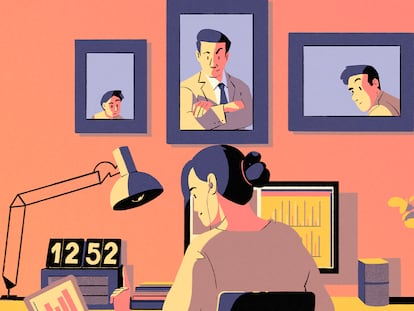Active breaks: Simple tricks to alleviate the effects of a sedentary lifestyle at work
Those who sit for more than eight hours a day have a higher risk of suffering from myocardial infarction, cerebrovascular accidents, heart failure and more. Here’s what you can do

John is always happy to go to work. On his way to his job, he strolls along the way, taking note of every single detail, no matter how small. However, lately he has been feeling like the hours are too long. Something is not quite right. His body feels cramped and stiff, he has trouble focusing and, sometimes, he feels the need to stretch and shout. John could be any person between the ages of 25 and 64 who spends an average of five to eight hours sitting. The evidence that sitting for long hours causes a myriad of problems is beyond dispute: it is associated with a higher risk of heart disease, stroke and related diseases.
An interesting longitudinal study carried out over more than ten years with the involvement of more than 100,000 participants and 21 countries, recently published in JAMA Cardiology, concludes that those who spend more than eight hours sitting have a 17% to 50% higher risk of mortality from myocardial infarction, cerebrovascular accidents, heart failure or cardiovascular deaths than those who spend less than four hours sitting. Furthermore, the range increases if daily physical activity is not performed.
Including short breaks during the work day can help alleviate many of these problems. This idea is associated with the concept of active breaks: brief periods of physical activity during working hours. At present, there is no specific consensus regarding the structure, frequency, duration and type of exercise that should be performed, as it depends on the kind of work a person does and the health-related factors analyzed.
However, there is some noteworthy evidence. First, it has been proven that taking a light five-minute walk for every 30 minutes of sitting produces a decrease in blood pressure and blood glucose. Also, performing a brief strength training routine every 60 minutes (two series of 15 repetitions of three to four exercises that activate the large muscle groups) has a positive effect on the mental fatigue of the worker, as well as being linked to benefits related to discomfort or drowsiness. This is also achieved by taking breaks and combining stretching, mobilization and relaxation.
Perhaps one of the biggest concerns regarding the sedentary behavior at work is the number of musculoskeletal problems produced by maintaining a posture for long hours. This is a matter that not only interests workers, but also companies and employers who are beginning to notice how including active rest initiatives during work hours leads to fewer sick leaves due to problems associated with the musculoskeletal system.
There is no magic recipe for the active break; just moving is already beneficial at the musculoskeletal level. In general terms, breaks of 10 to 15 minutes are recommended for every 40 to 60 minutes of continuous work. This can be substituted with breaks of three to five minutes every half hour. The type of exercise can be very varied: stretching, core or strength training, or even ergonomic interventions. Strength training seems to be more effective for people that spend many hours sitting, or even standing.
After six weeks, a decrease in neck or shoulder pain begins to be observed, mostly at the lumbar level. But the benefits extend to increasing general strength, which has a positive impact on the person’s daily life. Stretching or mobility training is usually more feasible for those who spend many hours sitting; with just five-minute breaks, standing up and stretching, improvements can be achieved not only on the perception of pain, but the levels of muscle fatigue also decrease, achieving a state of non-fatigue for the next 30-45 minutes.
In addition to these initiatives, there are other small actions that can be included in the work routine – always depending on each person’s occupation:
- Walk to work. If you use public transportation, get off a few minutes before arriving at the office.
- Use the stairs whenever you can.
- When you go to the restroom, use one that is one floor up or down.
- Stand up while you talk on the phone.
- Whenever possible, stand while you chat with your co-workers.
- Stand up and sit down several times in a row whenever you can.
- Stand up while you work or study, or walk around briefly.
- Stand up and stretch your body, even for a few seconds.
- Use the stairs instead of the elevator.
Asian culture can help us understand how small habits can translate into better health, motivation and work performance. Two examples can be found in the culture of rajio taiso (a short exercise routine broadcast daily on Japan’s national radio) and the chorei meetings (held early in the morning with the entire team, to energize all employees before starting the day). In any case, the need to move and reduce sedentary time, if we want a better quality of life, is indisputable.
Gema Torres Luque is a professor at the Faculty of Humanities and Education Sciences of the University of Jaen, in Spain. CEDA Research Group (Science, Education, Sports and Physical Activity). @letrasdegematorres.
Sign up for our weekly newsletter to get more English-language news coverage from EL PAÍS USA Edition
Tu suscripción se está usando en otro dispositivo
¿Quieres añadir otro usuario a tu suscripción?
Si continúas leyendo en este dispositivo, no se podrá leer en el otro.
FlechaTu suscripción se está usando en otro dispositivo y solo puedes acceder a EL PAÍS desde un dispositivo a la vez.
Si quieres compartir tu cuenta, cambia tu suscripción a la modalidad Premium, así podrás añadir otro usuario. Cada uno accederá con su propia cuenta de email, lo que os permitirá personalizar vuestra experiencia en EL PAÍS.
¿Tienes una suscripción de empresa? Accede aquí para contratar más cuentas.
En el caso de no saber quién está usando tu cuenta, te recomendamos cambiar tu contraseña aquí.
Si decides continuar compartiendo tu cuenta, este mensaje se mostrará en tu dispositivo y en el de la otra persona que está usando tu cuenta de forma indefinida, afectando a tu experiencia de lectura. Puedes consultar aquí los términos y condiciones de la suscripción digital.
More information
Últimas noticias
Chris Martin, Taylor Swift, Elijah Wood and other famous wedding ‘crashers’
‘How does it feel to be a failure?’: Elizabeth Berkley’s journey from ‘Showgirls’ ridicule to vindication
The story of the Málaga virus: The code that haunted Google’s cybersecurity center director for 30 years
The impact of Ecuador’s mega-prison: A polluted river, cleared forests and military checkpoints
Most viewed
- Christian Louboutin: ‘Young people don’t want to be like their parents. And if their parents wear sneakers, they’re going to look for something else’
- The low-cost creative revolution: How technology is making art accessible to everyone
- Liset Menéndez de la Prida, neuroscientist: ‘It’s not normal to constantly seek pleasure; it’s important to be bored, to be calm’
- All the effects of gentrification in one corner of Mexico’s Colonia Roma
- December Social Security and SSI payments: Dates, double checks and the 2026 COLA increase










































